Table of Contents
- Introduction
- Editor’s Choice
- Global Physical Security Market Overview
- Key Reasons for Causing Security Incidents
- Widely Used Physical Security Solutions
- Impact of Security Incidents On Business
- Strategies Adopted by Businesses in Improving Physical Security
- Use of Remote Video Monitoring (RVM) Solutions for Physical Security
- Consumer and Business Response to Physical Security
Introduction
According to Physical Security Statistics, Physical security constitutes a crucial element of comprehensive security strategies, encompassing measures to protect physical assets, individuals, and information from unauthorized access, theft, harm, and damage. This encompasses access control, perimeter protection, surveillance, security personnel, intrusion detection, alarm systems, locks, and secure storage, all designed to counteract threats like break-ins, vandalism, workplace aggression, and natural disasters.
Physical security often aligns with other security domains, such as cybersecurity, and necessitates adherence to applicable regulations. Assessing risks plays a central role in customizing security measures to specific requirements. At the same time, continuous maintenance and assessment are imperative to adapt to evolving threats and ensure the efficacy of safeguarding mechanisms.
Editor’s Choice
- In 2022, the Physical Security market revenue stood at USD 132.5 billion, and it is expected to increase to USD 278.1 billion in 2032.
- A significant 75% of companies place physical security as one of their foremost priorities.
- Over the past five years, 60% of companies have encountered breaches in their physical security measures.
- The estimated average cost of addressing a physical security breach is approximately $100,000.
- Security measures such as surveillance systems, including security cameras, have been adopted by 40% of companies to enhance physical security.
- Access control systems, such as biometric scanners and keycard systems, have been deployed for physical security by 30% of companies.
- Security enhancements in fencing, gates, and barriers have been implemented by 25% of companies to bolster physical security.
- A notable 20% of companies have invested in educating their employees about best practices in physical security.
- Visitor management systems have been integrated for physical security purposes by 15% of companies.
Global Physical Security Market Overview
Global Physical Security Market Size
- The physical security market is showing steady growth in terms of revenue, with the figures projected to rise consistently in the coming years at a CAGR of 7.9%.
- In 2022, the market revenue stood at USD 132.5 billion, expected to increase to USD 143.0 billion in 2023.
- The market is poised to exceed USD 236.6 billion in 2030 and continue its upward trajectory, reaching USD 255.3 billion in 2031 and USD 278.1 billion in 2032.
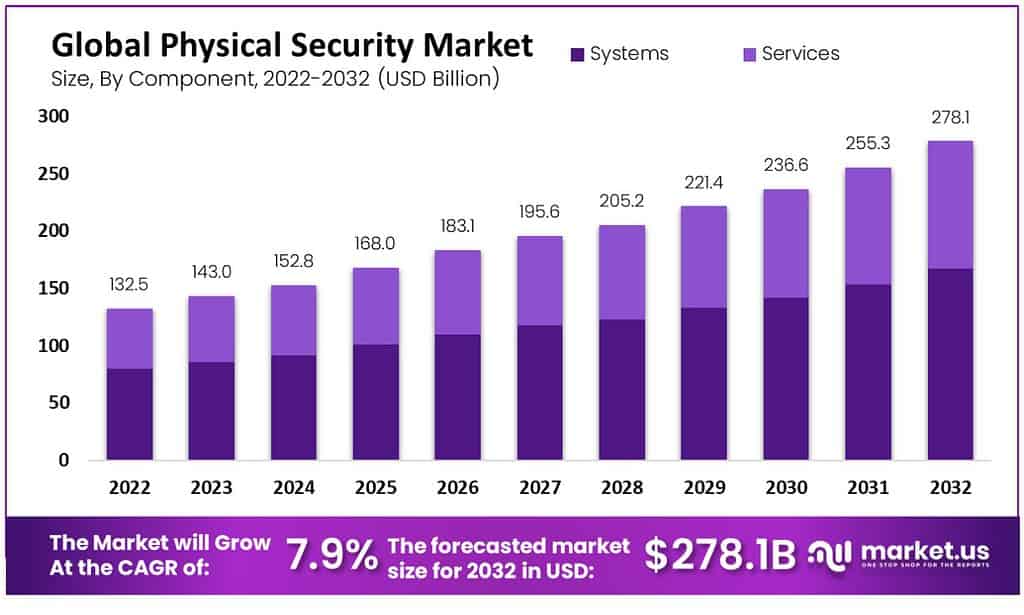
Physical Security Market Revenue – By Component
- The global physical security market has witnessed significant growth in recent years, with the total revenue reaching USD 132.5 billion in 2022.
- This revenue is primarily driven by two key components: systems and services, which contributed USD 79.5 billion and USD 53 billion, respectively, to the overall market.
- The market is expected to continue its upward trajectory, with total revenue projected to reach USD 143.0 billion in 2023, representing a steady increase.
- Systems are anticipated to generate USD 85.8 billion, while services are expected to contribute USD 57.2 billion in 2023.
- Over the next decade, the market is forecasted to experience substantial growth, with total revenue reaching USD 255.3 billion by 2031.
- Systems and services will play integral roles, with estimated contributions of USD 153.2 billion and USD 102.1 billion that year.
Global Physical Security Market- By End-Use Industry
- The global physical security market in various end-use industries exhibited a market share distribution in 2022.
- Government entities held a significant portion of the market at 20%, emphasizing the importance of security measures in public sectors.
- Transportation followed closely, representing 18% of the market, highlighting the need for safeguarding critical infrastructure in the travel and logistics sector.
- With a 15% market share, retail recognized the significance of security in protecting stores and merchandise.
- Residential areas accounted for 7% of the market, emphasizing the relevance of security solutions for home safety.
- The industrial sector contributed 9% of the market share, underscoring the importance of security measures in safeguarding manufacturing facilities and critical infrastructure.
- The banking, financial services, and insurance (BFSI) sector constituted 14% of the market, acknowledging financial institutions’ critical need for security.
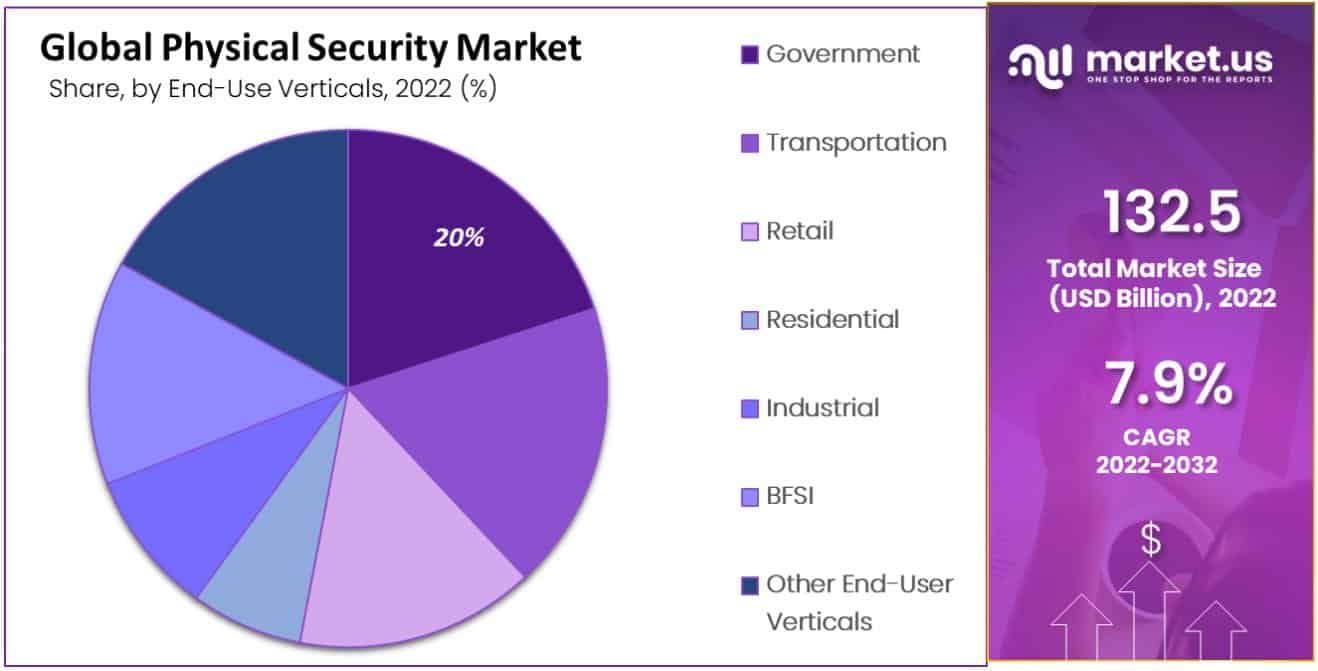
Security Services Market- By Region
- In Europe, the market size was 29 billion USD in 2015, which decreased to 20 billion USD in 2017 and further declined to 19 billion USD in 2018.
- It decreased to 15 billion USD in 2019 and remained stable at 15 billion USD in 2020.
- Asia (excluding Japan) started at 30 billion USD in 2015 and experienced fluctuations over the years, reaching 28 billion USD in 2018, then dropping significantly to 11 billion USD in 2019 before recovering to 19 billion USD in 2020.
- North America had a market size of 36 billion USD in 2015, declining to 32 billion USD in 2017 and 29 billion USD in 2018.
- In 2019, it saw a significant drop to 12 billion USD but rebounded to 19 billion USD in 2020.
- The Middle East & Africa region maintained a relatively stable market size, hovering around 36 to 31 billion USD from 2015 to 2018, with a drop to 12 billion USD in 2019 and a subsequent recovery to 19 billion USD in 2020.
- Latin America started at 36 billion USD in 2015 and remained relatively stable through 2018 at around 32 billion USD.
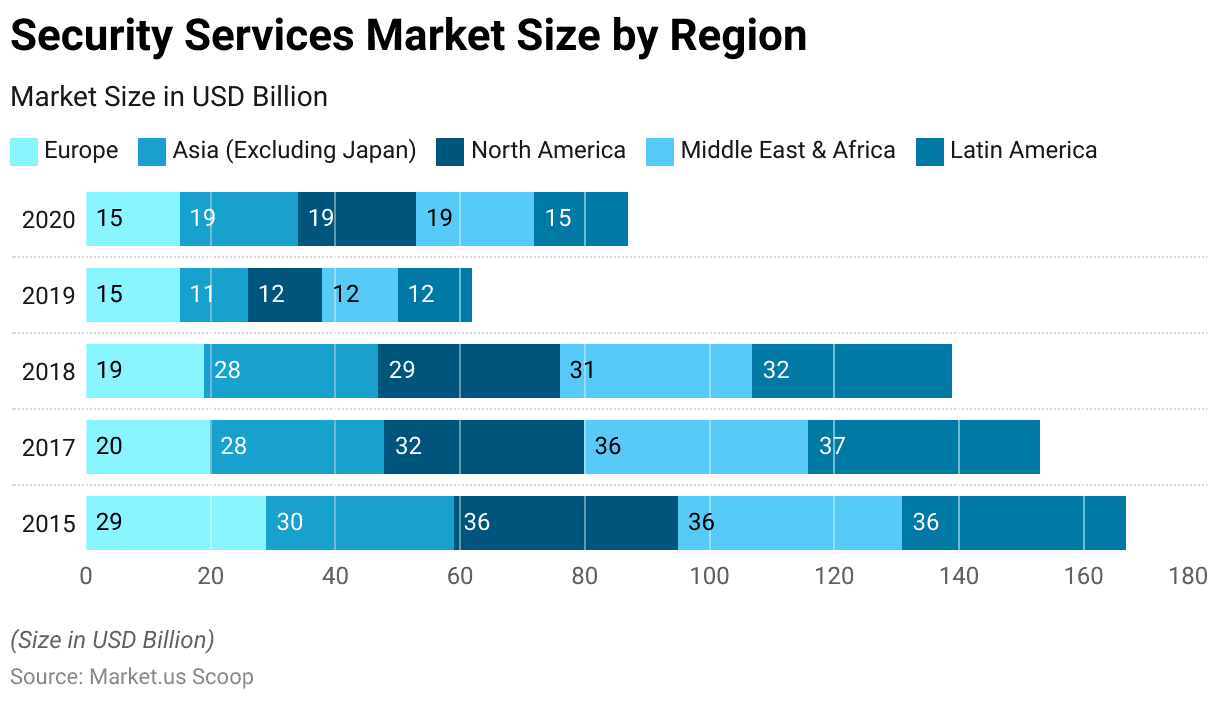
Key Reasons for Causing Security Incidents
- In 2022, various companies identified factors that contributed to increased security incidents.
- A negligible percentage, less than 1%, attributed the rise to reduced business hours, possibly indicating a minor impact.
- Insider problems, such as internal security breaches, were cited by 5% of companies as a contributing factor.
- A slightly larger proportion, 6%, pointed to security guard shortages as a challenge affecting security levels.
- Surprisingly, 11% of respondents admitted uncertainty about the exact causes of increased security incidents.
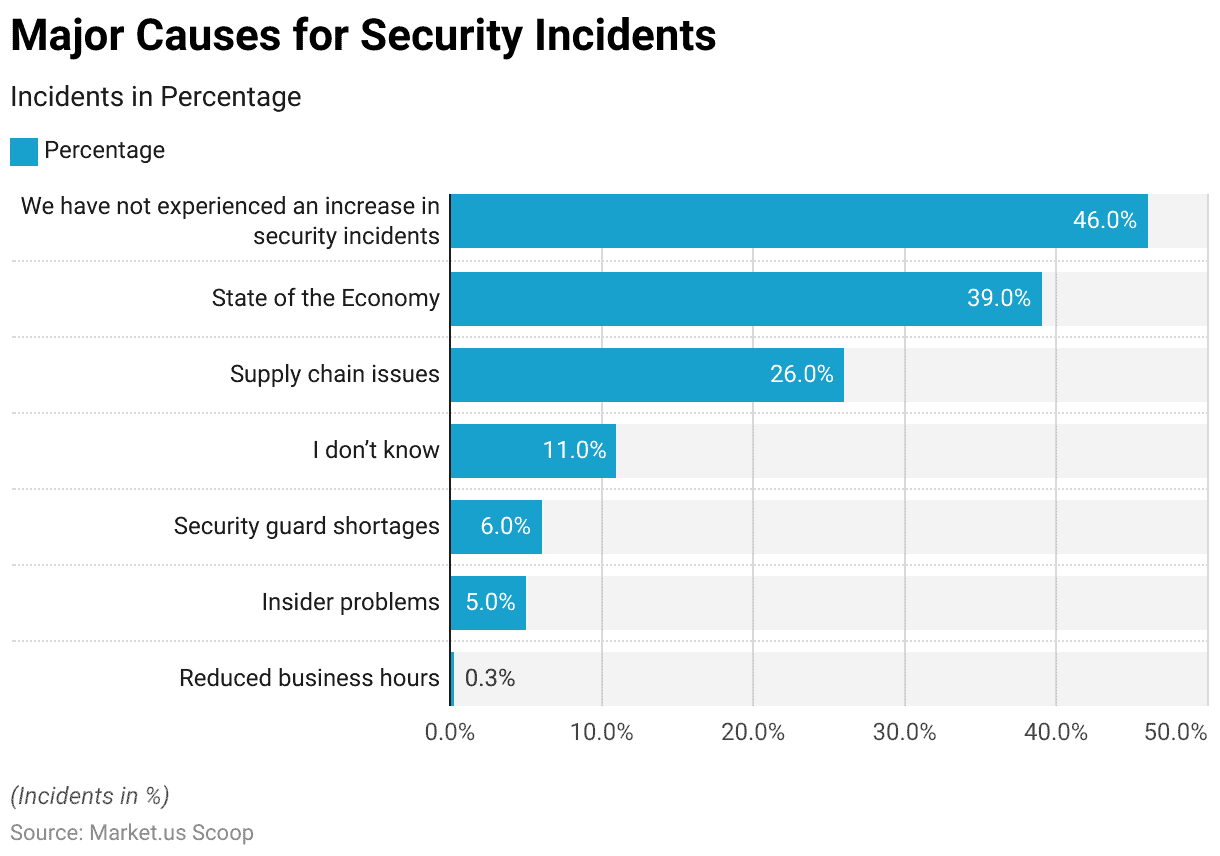
Widely Used Physical Security Solutions
- Access control dominates the widely used physical security solutions, commanding a substantial market share of 50%.
- Access control systems are pivotal in regulating and managing entry to secured areas, making them a fundamental component of security strategies across various sectors.
- Video surveillance follows closely, holding a significant 30% market share.
- The prevalence of video surveillance underscores its role in monitoring and recording activities in both public and private spaces, contributing to enhanced security and incident deterrence.
- Perimeter security solutions, with a 20% market share, also play a crucial role in safeguarding the boundaries of properties and facilities, preventing unauthorized access and potential threats.
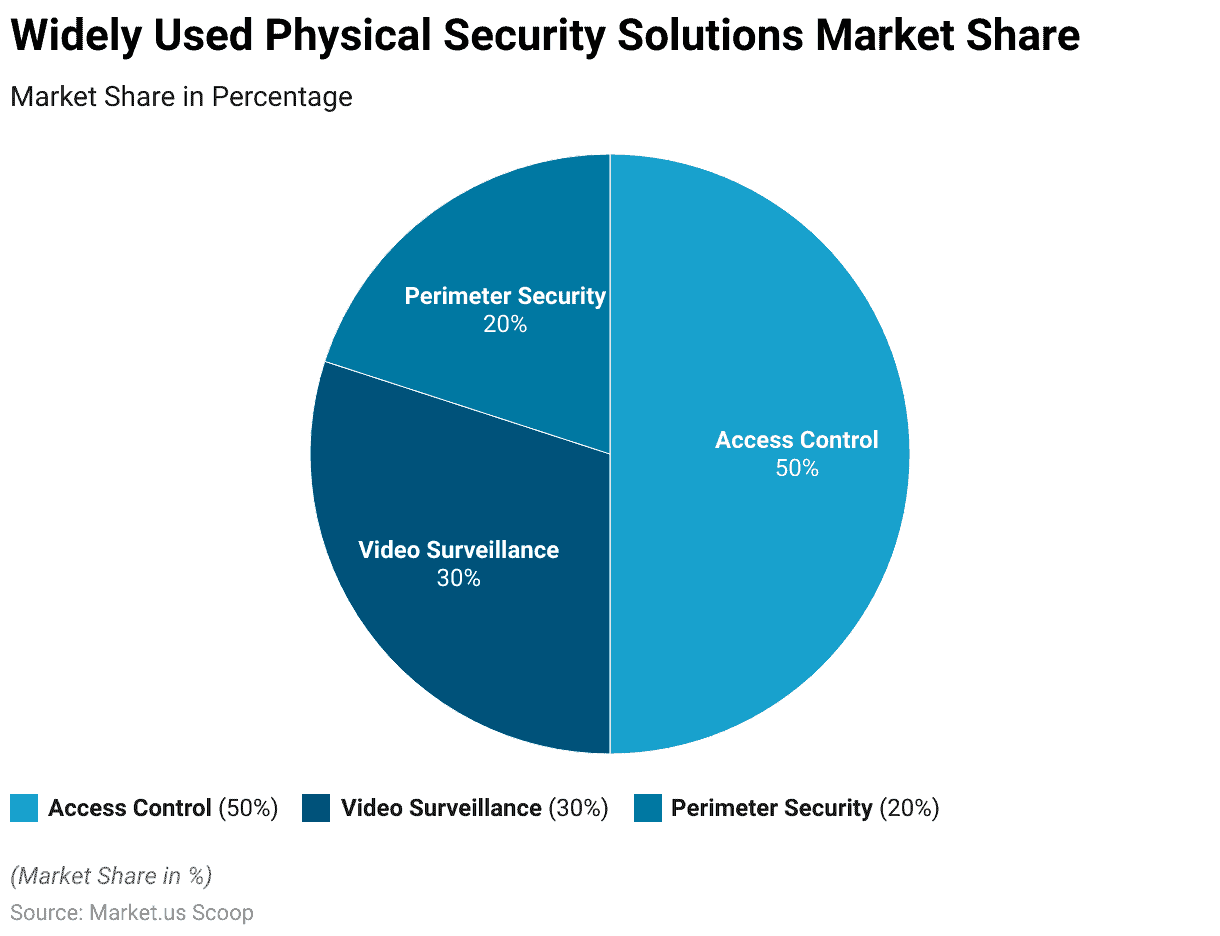
Impact of Security Incidents On Business
- Security incidents can have a significant impact on businesses across various dimensions. When assessing the effects of security incidents, several factors come into play.
- For instance, incidents may lead to changes in business hours, with approximately 2% of cases necessitating such adjustments.
- Additionally, brand damage can occur in 6% of instances, affecting a company’s reputation and credibility.
- Furthermore, customer service can be notably impacted, with around 18% of incidents influencing the quality of service provided to clients.
- The financial aspects of a business are also vulnerable, with cash flow suffering in 25% of cases due to security incidents.
- Project delays are another significant concern, with approximately 40% of incidents causing disruptions in project timelines.
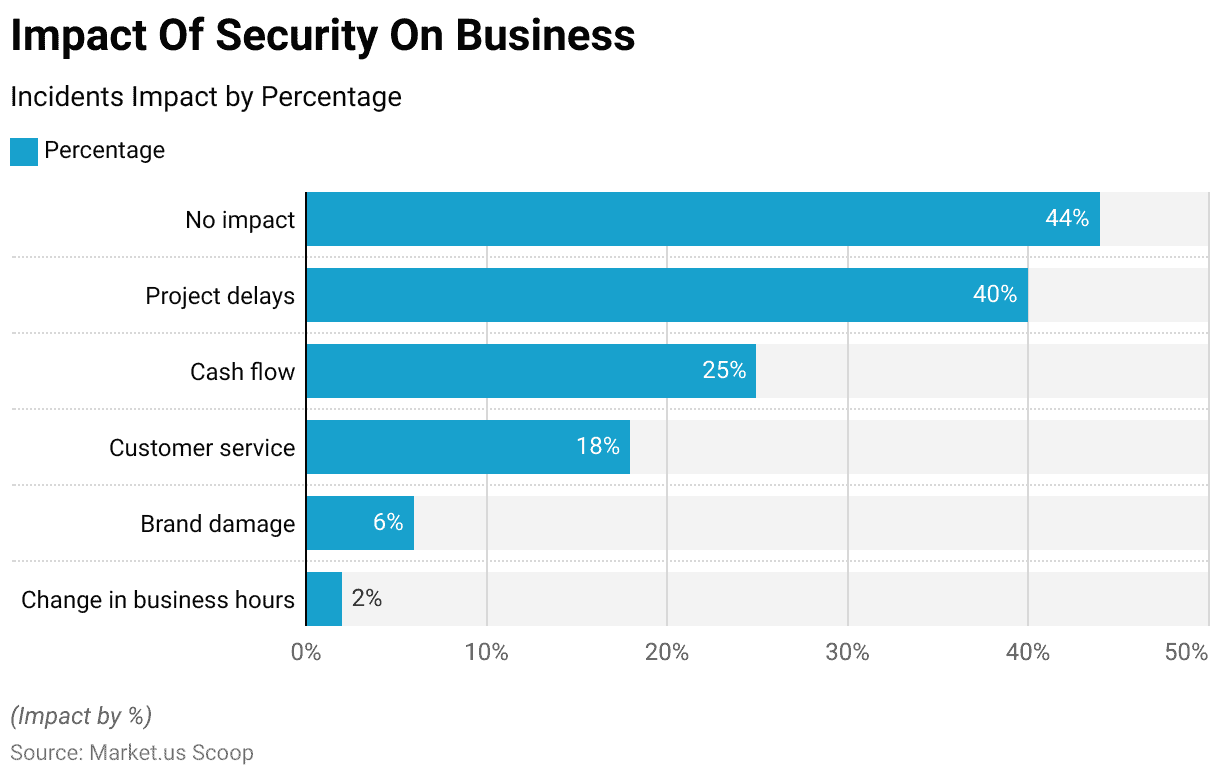
Strategies Adopted by Businesses in Improving Physical Security
- In 2022, businesses implemented various changes to their physical security strategies to enhance their protection measures.
- Notably, 47% of businesses installed security video cameras, utilizing advanced surveillance technology to monitor and safeguard their premises.
- Furthermore, 22% of businesses opted to strengthen their security by installing fencing fortifying their perimeters to deter potential threats.
- A significant portion, 14%, adopted remote video monitoring (RVM) systems, allowing for real-time surveillance from remote locations.
- Alarm systems also gained prominence, with another 14% of businesses choosing to install them, providing immediate alerts in case of security breaches.
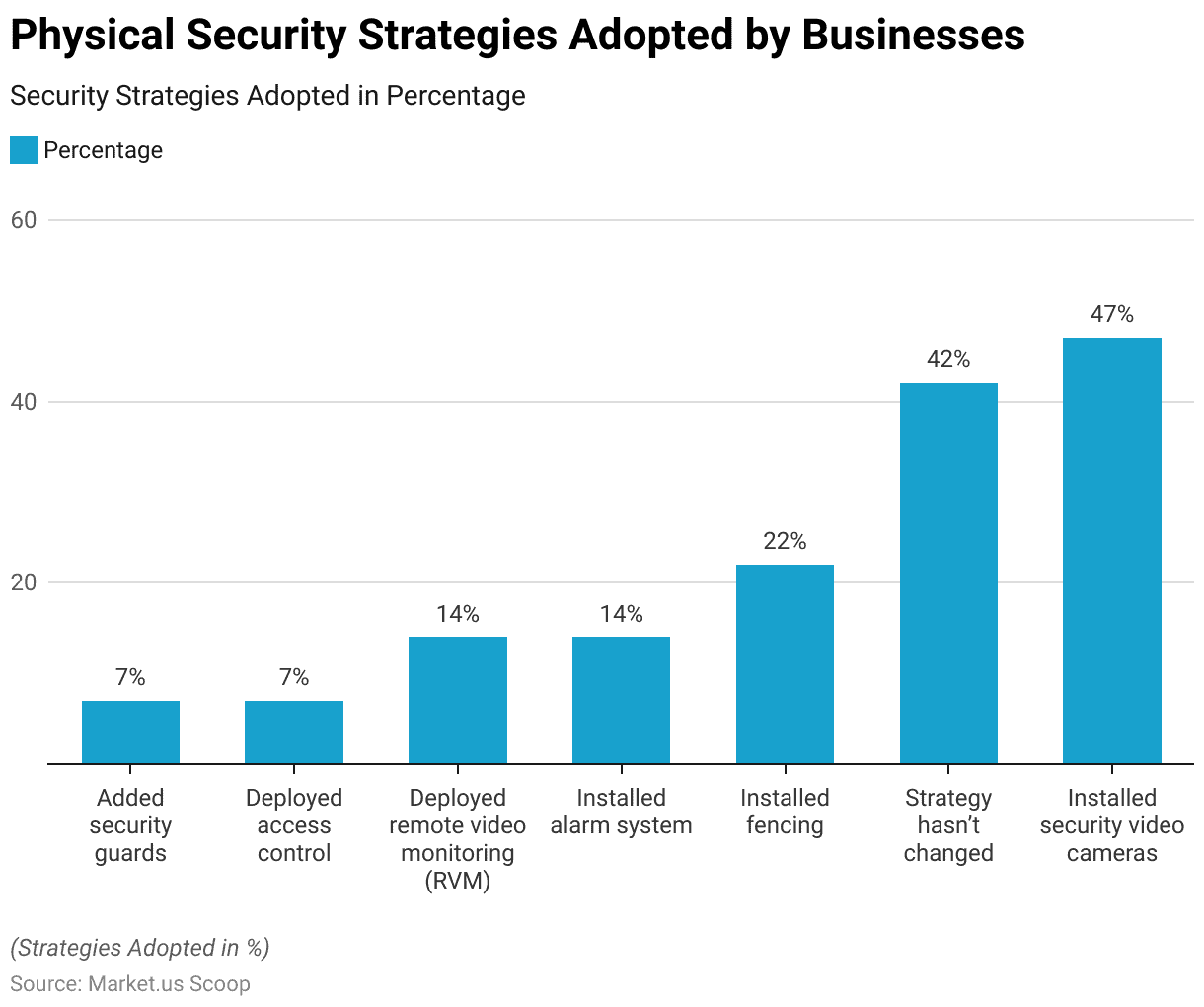
Use of Remote Video Monitoring (RVM) Solutions for Physical Security
- Businesses employ various approaches to video surveillance as part of their security strategies.
- A significant portion, 41%, utilize remote video monitoring, which allows for real-time surveillance and proactive response to security events.
- In contrast, 27% of businesses reported not using video surveillance as security measures.
- Meanwhile, 32% of businesses employ a more straightforward approach, opting for simple video recording and storage without real-time monitoring.
- These choices reflect the diversity of strategies businesses employ in managing video surveillance as an integral component of their security solutions, with some prioritizing real-time monitoring for immediate threat detection. In contrast, others opt for more passive recording and storage options.
- Among those currently implementing remote video monitoring (RVM) as part of their security measures, nearly half (45%) have extended its applications beyond security-related functions, thus enhancing the value it brings to their business operations.
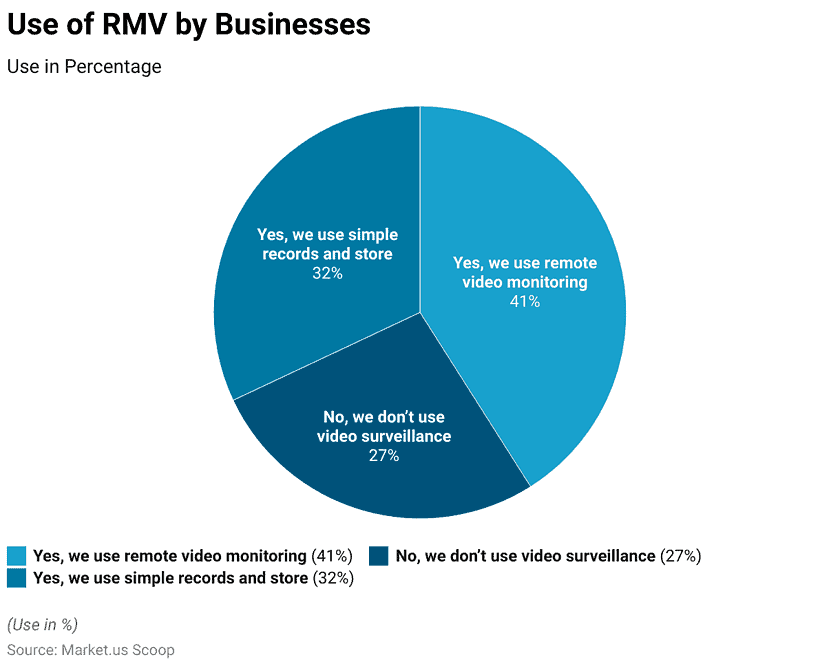
Consumer and Business Response to Physical Security
- 81% of the respondents heavily rely on mobile applications, whereas only 25% have embraced mobile credentials for security management.
- According to a recent survey conducted by ProVigil, a provider of remote video monitoring services, nearly 20% of the 124 business operations leaders who participated in the survey reported an increase in physical security incidents compared to the previous year.
- Concerns surrounding physical security have prompted 40% of the surveyed organizations to revise their security strategies, including a heightened use of video cameras and security personnel since the onset of the pandemic.
- The survey commissioned by Ontic also revealed that 43% of respondents found it challenging to ensure the safety of remote employees, while 36% faced difficulties securing physical access to corporate data.
Discuss your needs with our analyst
Please share your requirements with more details so our analyst can check if they can solve your problem(s)



